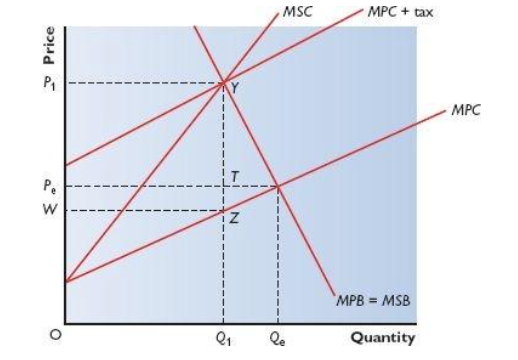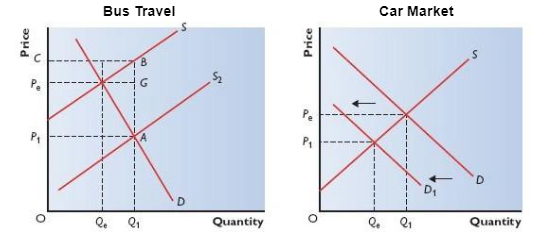Government Intervention - A-Level Economics
Government Intervention
Markets fail when the price mechanism causes an inefficient allocation of resources.
Governments have to step in to correct market failure.
Indirect Taxation
Indirect Taxes: how they work
Indirect taxes are taxes levied on expenditure of goods and services. Externalities result in market failure, because:
🗶 Goods with negative externalities are over‐consumed
🗶 Goods with positive externalities are under‐consumed.
To address over‐consumption of demerit goods (e.g. petrol, alcohol and tobacco), the government often impose indirect taxes.
Example: Indirect Tax on Petrol
Petrol is a demerit good‐ it has negative externalities (e.g. pollution) and is over-‐consumed in the free market.

From the graph above, we can learn that:
- Consumption of petrol has a negative externality equal to the line ZY
- The current free‐market equilibrium quantity is Qe
- The social optimum equilibrium is Q1
The government can impose a tax equal to the external cost of ZY, and this would work to internalise the externality (i.e. bring it into the price mechanism).
Total Tax Revenue = P1YZW
Indirect Taxes: Assessment
Advantages
- They are an effective way of internalising negative externalities, allowing the socially optimum point to be reached
- Tax revenue received by the government can be used to further deal with the externality or compensate sufferers (e.g. with the petrol tax, the government could use tax funds to clean up the environment or subsidise bus services)
Disadvantages
- It is difficult to quantify the externality and place a monetary value on it. Therefore, it is difficult to choose the correct tax level‐too high a tax will lead to under‐consumption, whilst too low a tax will not completely internalise the externality
- Indirect taxes are often partly paid for by the producer, so production costs of UK firms rises, making them less competitive in the global market
- Firms might decide to relocate to other countries which have lower taxes
- The effect depends on the price elasticity of the good. Petrol, for example, is inelastic, so a very high tax will be required to reduce consumption.
- Taxes might lead to the development of illegal markets (e.g. tobacco and alcohol are sold on the ‘black market’ to avoid high taxes)
Subsidies
Subsidies: how they work
A subsidy is a grant provided by the government to encourage the production and consumption of a good or service.
As discussed above, market failure also occurs when merit goods with positive externalities are under‐consumed. Subsidies are often placed on these goods to encourage their use.
However, subsidies can also be placed on goods that are substitutes to demerit goods. For example, a subsidy for bus travel will have the indirect effect of reducing demand for car travel and hence petrol.
Example: Bus Travel

Subsidy = AB Total Government Expenditure = ABCP1
The subsidy will reduce production costs of bus travel suppliers, leading to an outward shift of the supply curve. This leads to an increase in the quantity of bus travel consumed.
The second graph shows that the increase in consumption of bus travel will reduce the demand for car travel.
Subsidies: Assessment
Advantages
- They work with the market to reduce demand for demerit goods and increase demand for merit goods
- Reduce production costs for firms, making them more competitive in global markets
- The subsidies might attract other firms into the market. These firms could switch from one field (e.g. coach travel) to bus travel, or might come from abroad. This will increase supply further, leading to a greater fall in demand for car travel.
- Firms will have more money to invest elsewhere (e.g. on improving quality of the good or service)
Disadvantages
- There is an opportunity cost of government expenditure on subsidies‐the money could have been used elsewhere (e.g. to reduce taxes or improve healthcare)
- Firms might become complacent and rely on subsidies, which might lead to a fall in efficiency
- The Emissions Trading System (ETS) is a system which works to reduce carbon emissions
- The European Commission allocate a certain quantity of carbon permits to national governments, who allocate the permits among firms covered by the scheme.
- The government normally keep 10% of carbon permits and sell them depending on the level of scarcity (e.g. if there was a shortage of steel, the government would sell the permits to steel companies)
- The scheme covers the type of firms who tend to produce lots of pollution, such as power generating companies and steel manufacturers.
- The pollution permits are tradable-firms can buy and sell allowances between themselves.
Tradable Pollution Permits
Advantages
- The permits cap the amount of emissions from countries, which reduces the negative externalities associated with pollution (e.g. global warming). The externality (pollution) is internalised, because firms have to pay for any pollution they produce, so the externality becomes part of their MPC.
- The scheme is flexible-allowances can be altered over time and allowances can be saved up by firms for future use.
- National governments can raise funds by selling their reserve pollution permits to firms, and the money raised can be used to clean up the environment or compensate victims
- Production costs will rise for firms that exceed their allowances, whilst production costs will fall for cleaner firms who can sell their excess allowances
- Firms have an incentive to invest in clean technology and to reduce pollution levels because doing so will reduce production costs
Disadvantages
- The European Commission might issue allowances that are too big, so the reduction in pollution is minimal. This happened in the early years of the scheme
- The European Commission might issue allowances that are too small, so firms will have to buy more allowances. Production costs will rise, leading to reduced international competitiveness, whilst some firms might move abroad (which might lead to structural unemployment).
- The trading system puts less pressure on big polluters because it allows them to simply buy more permits rather than forcing them to reduce emissions.
- Firms might pass costs of purchasing pollution permits to consumers in the form of higher prices (this is more likely to happen if demand is inelastic). This will lead to a rise in prices of commodities, such as steel and copper.
- The price of pollution permits has fluctuated greatly since their introduction in 2005. This means firms are unsure whether to invest in cleaner technology because they are unsure of future prices.
- There is a cost for the government to monitor pollution levels of firms covered by the scheme. There is an opportunity cost of the money and time spent on this.
- Disputes have risen over allocated carbon permits‐many firms have entered legal battles with the European Commission because they feel their allocation is too small.
- It is difficult to place a monetary value on the cost of pollution
Extension of Property Rights
Market failure often occurs because there are no property rights over areas such as the sea and the environment. For example, over‐fishing occurs in seas because there is a lack of property rights-no one owns the sea, so no one stops the fishermen.
The government can extend property rights, giving control of land to different organisations. These organisations have control over what uses the land can be put to. The property owners can charge firms who need to pollute the area, and use the funds the clear up. The owners can also fine and prosecute firms who pollute without permission.
Example: Property Rights on Seas
Fisherman go out to sea and catch as many fish as they can, considering short term profits rather than the long term viability of the industry. This over-fishing is an example of market failure. If all fisherman continue to over-fish, then the fish population will not be able to maintain its numbers through reproduction. The industry will eventually die.
The fisherman know of the problem, but there is no incentive to do anything about it. If one fisherman decides to think about the future and reduce his fishing, all the other fisherman will keep trying to catch as many fish as possible, so there is no point in him reducing his fishing because it will have no overall effect.
The solution is to extend property rights. If certain fisherman owned certain areas of the sea, and therefore had legal rights over them, then they would each have control over a certain area and could stop people from fishing in their area (or fine them if they do). They could then think about the future and only fish at certain times of the year, perhaps.
This is another example of internalising the externality. The externality has been brought back into the price mechanism. The market price of fish should now reflect the true supply of fish in the sea rather that the exaggerated supply that occurred with over-fishing.
N.B. Property rights can be over land or resources
Property Rights: Assessment
Advantages
- The property (land or resource) is more likely to be managed carefully to ensure its availability for the future
- The property owners can charge firms who need to pollute the property. The money can be used to clean up the environment and compensate sufferers.
- Firms that pollute without permission will face legal action
Disadvantages
- The process of extending property rights is very long and difficult
- It can be difficult to determine the exact source of pollution, so firms can get away with polluting without permission
- Prosecution and legal action involves high legal costs and is a very long process
- It is difficult to place a monetary value on polluting a property right
State Provision and Regulation
State Provision
The government has to provide public goods (e.g. defence, street lighting) because otherwise they would not be provided by the free market.
Often, the government also provide merit goods. These goods might still be provided in the market, but governments ensure that an adequate amount is provided. An example of this is the government provision of health care.
Regulation
Regulation refers to the laws enforced by the government.
Governments can prohibit the purchase of certain demerit goods. For example, certain drugs are illegal.
Governments can also restrict the purchase of certain demerit goods. For example, alcohol cannot be sold to anyone under the age of 18. Another example is the use of fish quotas, which restricts and limits fishing in seas.
Consumer protection laws can also help overcome the problem of asymmetric information. The laws protect consumers against firms who might sell poor-quality or unsafe goods, and against firms who make false claims about their products.
Regulation: Assesment
Advantages
- Clear laws are set, which are easy to understand
- Governments can shut down or fine firms who do not abide by the regulations
- Consumer protection laws protect consumers from being exploited by asymmetric information
Disadvantages
- Regulations can be expensive to monitor
- Firms might face extra costs (e.g. cost of installing pollution monitoring equipment)
- Regulations over-power the price mechanism rather than work with it
- There is the potential for government failure if regulations lead to a more inefficient allocation of resources
- There is no incentive for firms to reduced pollution levels below the legal limit. For example, with the emissions trading scheme firms would benefit by using less than their allocated limit, but with regulations there is no such benefit.
Case Studies: Government Intervention
Road Pricing
Road pricing aims to reduce the negative externalities of congestion, and in doing so bring about a more efficient allocation of resources (road space).
There are several negative externalities associated with road use:
- Air pollution
- Noise pollution
- Use of petrol
- Costs of policing
- NHS costs of treating injuries from car accidents
Road pricing effectively internalises these externalities. Also, road pricing increases government revenue, and the money could be spent on reducing the externalities further (e.g. by improving public transport).
However, some argue that it is unfair to ‘charge’ for a once ‘free’ good. Also, road pricing is a scheme which affects the poor more than the rich, and some may regard this as unfair.
Schemes such as road tool booths and congestion charges are example of road pricing.
Landfill Tax
The landfill tax is a tax levied on waste deposited in landfills.
There are several negative externalities associated with landfill sites:
- Landfills release chemicals into underground water
- Heavy lorries which transport waste cause noise and air pollution
- Unpleasant smell to the surrounding area
The tax has been effective in the sense that it has reduced deposition of waste in landfill sites, reduced the amount of waste produced, and encouraged recycling.
However, there has been an increase in people illegally dumping waste on private land they find.
Carbon Offsetting
Carbon offsetting scheme enables customers or producers to offset their carbon emissions by paying for the removal of the same amount of carbon emissions elsewhere.
Many airlines, banks and energy companies have set up carbon offsetting schemes for their own customers.
For example, when you buy a plane ticket you can pay an additional fee to have your carbon footprint offset. This means that to compensate for the carbon produced by the flight, environmentally friendly actions will take place, such as the planting of trees or provision of solar panels.
However, these schemes are very inefficient for several reasons:
- The system is voluntary, so most customers just ignore it
- The system is difficult to regulate and open to fraud
- There is normally a large time lag between the customer paying for the carbon to be offset and the appropriate action being taken
Renewable Energy Certificates
Renewable energy certificates were introduced by the government to encourage power-generating firms to use renewable energy resources (e.g. solar, wind, tidal power) to create electricity.
Firms involved are required to have 10% of their power generation from renewable resources. Firms unable to meet this target will have to purchase certificates from the government, the proceeds of which are distributed to companies who do meet the target. The price of the certificates is adjusted in line with inflation.
The scheme works similarly to the carbon trading system ‐ it rewards cleaner companies. The scheme encourages the use of renewable energy, which is an environmentally friendly substitute for fossil fuels.
Government intervention refers to the actions taken by the government to influence the market and regulate economic activity. It can take various forms, such as taxes, subsidies, price controls, and regulations.
There are three main types of government intervention: fiscal policy, monetary policy, and regulatory policy. Fiscal policy involves changes in government spending and taxation, monetary policy involves changes in the money supply and interest rates, and regulatory policy involves laws and regulations that affect economic activity.
The main reasons for government intervention in the economy are to correct market failures, promote economic growth and stability, redistribute income and wealth, and achieve social and political objectives.
Market failures refer to situations where the free market fails to allocate resources efficiently, resulting in a suboptimal outcome. Examples of market failures include externalities, public goods, and asymmetric information.
Taxes and subsidies are used by the government to influence market outcomes. Taxes can be used to discourage certain activities, such as smoking, while subsidies can be used to encourage certain activities, such as renewable energy.
Price controls refer to government-imposed limits on the prices of goods and services. Examples of price controls include minimum wage laws and rent controls.
The advantages of government intervention include correcting market failures, promoting economic stability, and achieving social and political objectives. The disadvantages include inefficiency, bureaucracy, and unintended consequences.
Fiscal policy involves changes in government spending and taxation, while monetary policy involves changes in the money supply and interest rates. Fiscal policy is used to influence aggregate demand in the short run, while monetary policy is used to influence aggregate demand and inflation in the long run.
Regulations are used by the government to ensure that economic activity is conducted in a safe and fair manner. Examples of regulations include environmental regulations and antitrust laws.
Government intervention can have both positive and negative effects on the economy. It can promote economic stability and growth, but it can also lead to inefficiency and unintended consequences. The effectiveness of government intervention depends on the specific policies and their implementation.






Still got a question? Leave a comment
Leave a comment